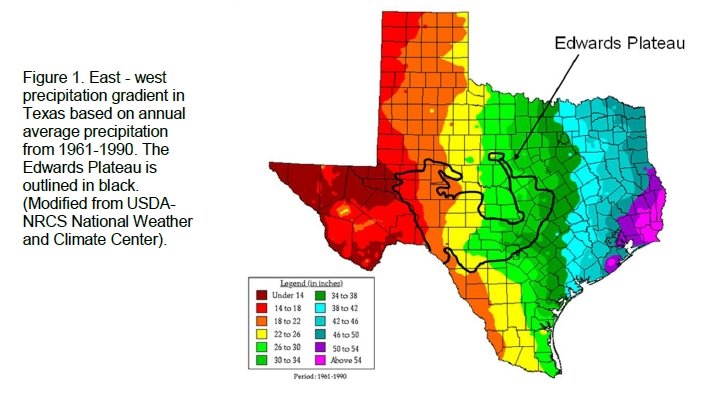The vast majority of climate models predict more variable rainfall with greater periods of drought in the next 50 to 100 years. However, researchers do not yet understand how increased drought and more variability in drought stress will affect ecosystem structure and function. For example, in ecosystems such as central Texas grasslands, where rainfall is already highly variable and drought can be severe, less rain or less frequent rain may push the ecosystem past a threshold, especially in an absence of brush management, to where grasslands are not sustainable.
Alternatively, drought-prone ecosystems that already face extremely variable rainfall may be well equipped to withstand increased drought. How drought alters ecosystem function will be important for both the ecosystem itself and for ecosystem feedbacks to climate change.
The Edwards Plateau in central Texas is an ideal location for addressing the effects of increased drought on grassland ecosystems, because soil type (limestone-derived mollisols) and vegetation (grassland savanna) are largely similar while rainfall declines from east to west (see photo below). Rainfall across the Plateau varies from about 36 inches in the east to about 16 inches in the west, with a decrease of about 4 inches every 25 to 30 miles.
In a drier future climate, eastern areas of the gradient may face conditions now represented in the west. Working in savanna grasslands across the Plateau will be informative for ecosystems beyond central Texas, as these habitats represent 30% of the terrestrial Earth surface and are predicted to become more prevalent with increased drought.
We will focus on rain effects on ecosystem carbon cycling because of the importance of soil organic matter to soil fertility and structure, as well as the impacts of carbon balance on ecosystem feedbacks to climate change. Increased drought is likely to affect ecosystem carbon cycling through plant productivity (inputs) and decomposition rates (fluxes).
We will use the Edwards Plateau rain gradient as a proxy for future climate, to help increase our understanding of how future drought will affect carbon cycling in central Texas grasslands. We will focus on plant productivity, standing pools of carbon in soils, the flux out of those pools (decomposition/ respiration), and the microbial drivers responsible for loss of carbon from the soil pool.
Project Objectives
- Define baseline plant productivity, soil carbon pools, soil carbon process rates, and soil microbial drivers across the rainfall gradient.
- Determine how changes in rainfall will affect plant productivity, soil carbon pools, process rates, and microbial drivers.
More on this study of climate change.
